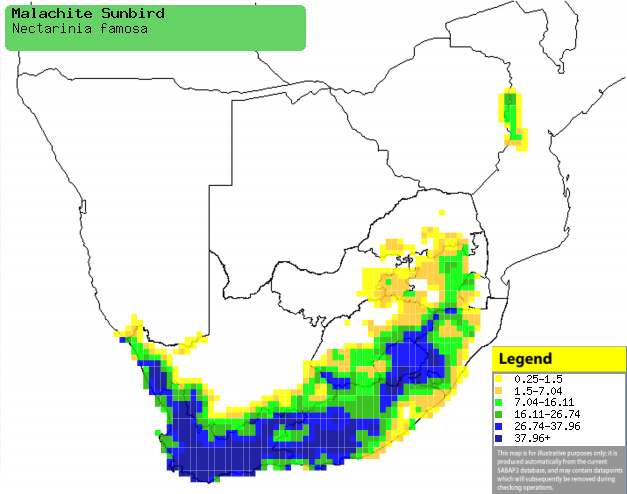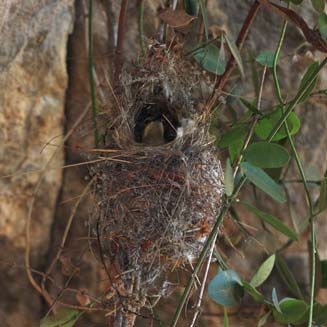|
Nectarinia famosa (Malachite
sunbird)
Life
> Eukaryotes >
Opisthokonta
> Metazoa (animals) >
Bilateria >
Deuterostomia > Chordata >
Craniata > Vertebrata (vertebrates) > Gnathostomata (jawed
vertebrates) > Teleostomi (teleost fish) > Osteichthyes (bony fish) > Class:
Sarcopterygii (lobe-finned
fish) > Stegocephalia (terrestrial
vertebrates) > Tetrapoda
(four-legged vertebrates) > Reptiliomorpha > Amniota >
Reptilia (reptiles) >
Romeriida > Diapsida > Archosauromorpha > Archosauria >
Dinosauria
(dinosaurs) > Saurischia > Theropoda (bipedal predatory dinosaurs) >
Coelurosauria > Maniraptora > Aves
(birds) > Order: Passeriformes
> Family: Nectariniidae
Distribution and habitat
It is discontinuous across East Africa, with a separate and
larger population in southern Africa. Here it occurs along the West coast of
South Africa bordering on Namibia, extending east through the Eastern Cape and
Lesotho to KwaZulu-Natal, Mpumalanga and the Limpopo Province. It also occupies
Zimbabwe's Eastern Highlands, bordering on Mozambique. It occurs in a variety of
habitats, ranging from alpine and montane grasslands to scrubby hillsides in
mountainous areas, as well as in arid steppes of Namaqualand, riverine thornbush,
gardens, parks and alien plantations.
|
 |
|
Distribution of Malachite sunbird in southern Africa,
based on statistical smoothing of the records from first SA Bird Atlas
Project (©
Animal Demography unit, University of
Cape Town; smoothing by Birgit Erni and Francesca Little). Colours range
from dark blue (most common) through to yellow (least common).
See here for the latest distribution
from the SABAP2. |
Brood parasites
It has been recorded as host of the
Klaas's cuckoo.
Food
Its diet is mainly made up of nectar supplemented with
small Arthropods. It usually forages singly or in pairs, but it may aggregate in
groups of over 100 at localised food sources (e.g. large clumps of flowering
Aloe). The following food items have been recorded in its diet:
- Nectar
- Aloe
- A. broomii (Snake aloe)
- A. ferox (Bitter aloe)
- A. hereroensis (Sand aloe)
- A. marlothii (Mountain aloe)
- A. arborescens (Krantz aloe)
- A. maculata (Soup aloe)
- Protea
- P. simplex
- P. roupelliae (Silver protea)
- P. caffra (Common protea)
- P. lacticolor (Hottentot white protea)
- P. angolensis (Northern protea)
- P. cynaroides
- P. gaguedi (African protea)
- P. madiensis
- P. neriifolia (Narrow-leaved protea)
- P. petiolaris (Sickle-leaved protea)
- Olea (wild olives)
- Cotyledon orbiculata (Varkoor)
- Watsonia (watsonia)
- Disa chrysostachya (disa)
- Kniphofia (torch lilies)
- Leonotis (wild daggas)
- Tecoma capensis (Cape-honeysuckle)
- Strelitzia
- Glischrocolla formosa
- Melianthus villosus (Maroon honey flower)
- Buddleja salviifolia (Sagewood)
- Greyia sutherlandia (Glossy bottlebrush)
- Jacaranda mimosifolia (Jacaranda)
- Nicotiana glauca (Wild tobacco)
- Arthropods
- Small lizards (rarely)
Breeding
- It is a monogamous, territorial solitary nester, with pair bonds only
lasting for the duration of the breeding season. A breeding pairs territory
can be as small as 800 metres squared and usually contains large clumps of
flowering plants. The male is hardly present during the whole breeding
process, occasionally bringing food to the female or chicks.
- The nest (see image below) is constructed solely by the female, and is a
teardrop-shaped construction built of dry grass and plant down bound with
spider web. It usually placed in a low bush 1-2 metres above ground.
 |
|
|
Malachite sunbird female in nest, which was placed
above the grave of Louie Leipold, located in the Cedarberg. [photo Duncan Robertson ©] |
|
- Egg-laying season peaks from September-December.
- It lays 1-4 eggs which are incubated solely by the female for about
12-14 days. Every 15-50 minutes it takes a break to go foraging - the male
rarely brings her food.
- The chicks are cared for mainly the female, staying in the nest for
about 13-17 days, becoming independent up to 24 days later.
Threats
Not threatened.
References
-
Hockey PAR, Dean WRJ and Ryan PG 2005. Roberts
- Birds of southern Africa, VIIth ed. The Trustees of the John Voelcker
Bird Book Fund, Cape Town.
|
